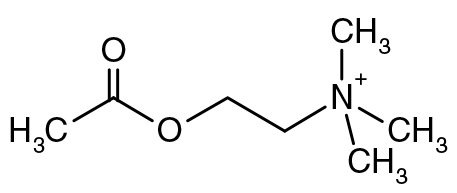A naturally occurring quaternary ammonium cation ester, with the formula CH3(O)COC2H4N(CH)3+, that plays a prominent role in nervous system function. The great importance of acetylcholine derives from its role as a neurotransmitter for cholinergic neurons, which innervate many tissues, including smooth muscle and skeletal muscle, the heart, ganglia, and glands. The effect of stimulating a cholinergic nerve, for example, the contraction of skeletal muscle or the slowing of the heartbeat, results from the release of acetylcholine from the nerve endings.
Acetylcholine is synthesized at axon endings from acetyl coenzyme A and choline by the enzyme choline acetyltransferase, and is stored at each ending in hundreds of thousands of membrane-enclosed synaptic vesicles. When a nerve impulse reaches an axon ending, voltage-gated calcium channels in the axonal membrane open and calcium, which is extremely low inside the cell, enters the nerve ending. The increase in calciumion concentration causes hundreds of synaptic vesicles to fuse with the cell membrane and expel acetylcholine into the synaptic cleft (exocytosis). The acetylcholine released at a neuromuscular junction binds reversibly to acetylcholine receptors in the muscle end-plate membrane, a postsynaptic membrane that is separated from the nerve ending by a very short distance. The receptor is a cation channel which opens when two acetylcholine molecules are bound, allowing a sodium current to enter the muscle cell and depolarize the membrane. The resulting impulse indirectly causes the muscle to contract.

مقالات قد تفيدك :
 مصادر الكيمياء موقع لتعليم الكيمياء بصورة مبسطة
مصادر الكيمياء موقع لتعليم الكيمياء بصورة مبسطة